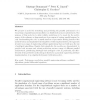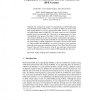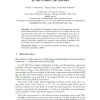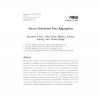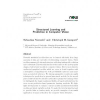132
Voted
ASIACRYPT
2011
Springer
14 years 1 months ago
2011
Springer
A cryptographic assumption is the (unproven) mathematical statement that a certain computational problem (e.g. factoring integers) is computationally hard. The leakage-resilience l...
189
Voted
AES
2011
Springer
14 years 1 months ago
2011
Springer
We propose a model for describing and predicting the parallel performance of a broad class of parallel numerical software on distributed memory architectures. The purpose of this ...
144
click to vote
PKC
2011
Springer
14 years 3 months ago
2011
Springer
At TCC 2005, Groth underlined the usefulness of working in small RSA subgroups of hidden order. In assessing the security of the relevant hard problems, however, the best attack co...
170
Voted
PKC
2011
Springer
14 years 3 months ago
2011
Springer
ded abstract of this work appears in Public Key Cryptography — PKC 2011, ed. R. Gennaro, Springer LNCS 6571 (2011), 1–16. This is the full version. We propose a linearly homom...
139
click to vote
PKC
2011
Springer
14 years 3 months ago
2011
Springer
We investigate the security of a generalization of HFE (multivariate and odd-characteristic variants). First, we propose an improved version of the basic Kipnis-Shamir key recovery...
154
click to vote
PKC
2011
Springer
14 years 3 months ago
2011
Springer
Bos, Kaihara, Kleinjung, Lenstra, and Montgomery recently showed that ECDLPs on the 112-bit secp112r1 curve can be solved in an expected time of 65 years on a PlayStation 3. This p...
125
Voted
PKC
2011
Springer
14 years 3 months ago
2011
Springer
xtended abstract which appears in the 2011 International Conference on Theory and Practice in Public Key Cryptography PKC 2011 (6–9 march 2011, Taormina, Italy) D. Catalano, N. F...
236
Voted
FUIN
2011
14 years 4 months ago
2011
In this article, a novel concept is introduced by using both unsupervised and supervised learning. For unsupervised learning, the problem of fuzzy clustering in microarray data as ...
110
click to vote
FTDB
2011
14 years 4 months ago
2011
We present a survey of the various families of approaches to secure aggregation in distributed networks such as sensor networks. In our survey, we focus on the important algorithm...
139
Voted
FTCGV
2011
14 years 4 months ago
2011
Powerful statistical models that can be learned efficiently from large amounts of data are currently revolutionizing computer vision. These models possess a rich internal structur...

